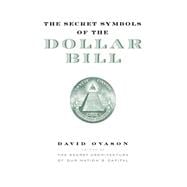
The New copy of this book will include any supplemental materials advertised. Please check the title of the book to determine if it should include any access cards, study guides, lab manuals, CDs, etc.
The Used, Rental and eBook copies of this book are not guaranteed to include any supplemental materials. Typically, only the book itself is included. This is true even if the title states it includes any access cards, study guides, lab manuals, CDs, etc.
1. The symbol $ for the dollar does not appear on the dollar bill.
It is a curious fact that the official symbol for the dollar, does not appear on the bill. The word DOLLAR appears only twice -- once on either side of the note.
2. The word dollar came to America from Germany.
The word dollar is derived from the German taler. The name taler was first given to silver coins made in 1519. This metal was mined in Joachimsthal (Joachim's valley, or thaler), in what was then Bohemia.
The obverse of one thaler showed the crucified Christ. On the reverse was the image of a serpent, hanging from a cross.
Near the serpent's head are the two letters NU, and on the other side of the cross, the number 21. This is a reference to Numbers, chapter 21, of the Bible.
In this chapter, we learn of the people of Israel who began to speak against God because of their tribulations and because they feared that they would die in the wilderness. As punishment, God sent against them fiery serpents. These bit many of the Israelites, as a result of which a number died. The people of Israel recognized their sin and begged for forgiveness. God instructed Moses to make a fiery serpent and set it upon a pole. Thereafter, anyone who looked upon that image would be cured. Moses did as he was ordered and raised a brazen serpent on a pole; all those who gazed upon it lived. It is this healing metal serpent that is shown on the reverse of the thaler.
In this image, the pole has become a cross, as the artist wished to draw a parallel between the magical healing power of this brass serpent and the healing power of Christ, who hung upon the cross.
It is this origin that has led some historians to claim that the thaler image of the serpent-cross is the origin for the dollar sign,
The idea that the dollar symbol was derived from the cross of Christ was remembered in American literature in 1920, fifteen years before the new dollar bill was designed.
In his novel Main Street, Sinclair Lewis reports a conversation between "the half-Yank and half-Swede," Bjornstam and the heroine of the novel, Carol. Bjornstam, lamenting the power of bankers, points out that the dollar sign has "chased the crucifix clean off the map." This half-joke would have meaning only for those who knew that the dollar sign, $, had been derived from a crucifix: a few lines later on, Bjornstam admitted that he was a bookworm.
The Secret Symbols of the Dollar Bill
Excerpted from The Secret Symbols of the Dollar Bill: A Closer Look at the Hidden Magic and Meaning of the Money You Use Every Day by David Ovason
All rights reserved by the original copyright owners. Excerpts are provided for display purposes only and may not be reproduced, reprinted or distributed without the written permission of the publisher.